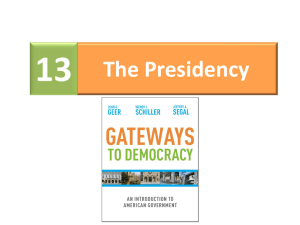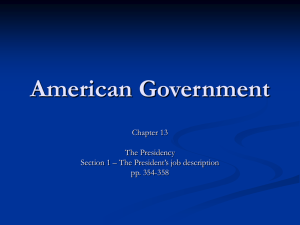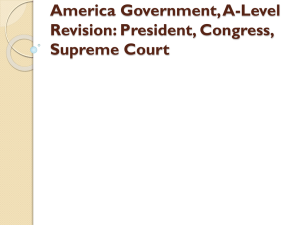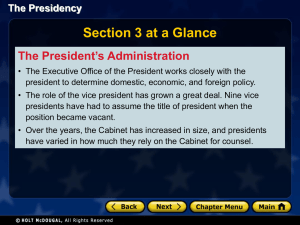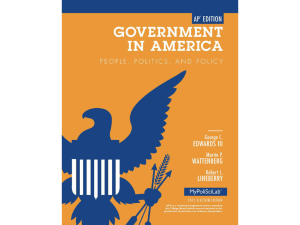The Executive Branch
advertisement
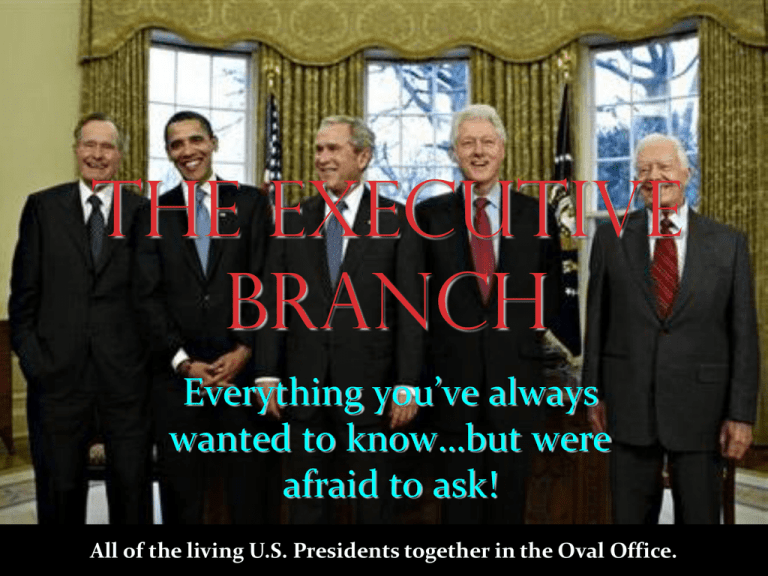
The Executive Branch Everything you’ve always wanted to know…but were afraid to ask! All of the living U.S. Presidents together in the Oval Office. • “A president's hardest task is not to do what is right but to know what is right.” • Lyndon B. Johnson • “With me it is exceptionally true that the Presidency is no bed of roses.” • James K. Polk Qualifications and Terms • According to Constitution: • President must be: – 35 years old – Natural-born citizen* – 14 years as resident • Terms of office: – 4 years – May serve 2 terms or 10 years From Title 8 of the U.S. Code Section 1401 A natural-born* citizen is • Anyone born inside the US • Any Indian or Eskimo born in the US provided being a citizen of the US does not impair the person's status as a citizen of the tribe • Anyone born outside the US, both of whose parents are citizens of the US as long as one parent has lived in the US • Any one born outside the US, if one parent is a citizen and lived in the US for at least one year and other parent is a US National • Any one born in a US possession, if one parent is a citizen and lived in the US for a least one year; • Any one found in the US under the age of five, whose parentage cannot be determined, as long as proof of non-citizenship is not provided by age 21; • Any one born outside the US, if one parent is an alien and as long as the other parent is a citizen of the US who lived in the US for at least five years (with military and diplomatic service included in this time) • A final, historical condition: a person born before 5/24/1934 of an alien father and a U.S. citizen mother who has lived in the U.S • "Mothers all want their sons to grow up to be president but they don't want them to become politicians in the process.” • John F. Kennedy Constitutional Powers • Constitution says little about presidential power. – Share executive, legislative, and judicial power with other branches of government. Expansion of Presidential Power • Today presidential power greater than Constitution suggests. • In 1950s and 1960s scholars tended to favor idea of strong presidency. – After abuses of power during Vietnam War and Watergate, scholars argued presidency had become too powerful Formal Presidential Powers Found in Constitution (Article II) • • • • • • • • • • • Executing (carrying out) laws; veto/pocket veto laws Commander-in-chief Negotiates/makes/signs treaties (NOT ratify!) Appoint federal justices and judges (NOT confirm!) Appoints ambassadors and foreign policy officials (NOT confirm!) Fill vacant government posts when the Senate is in recess May pardon individuals Recognizes nations Receives ambassadors and other heads of state May convene and/or adjourn both houses of Congress Must give message to Congress from time to time – Has become the State of the Union Address` Informal Presidential Powers Not in found in the U.S. Constitution • Crisis manager • Has access to expert – National Spokesman knowledge and expertise Makes executive orders and • De facto political party agreements – Does not have to be approved leader by Congress! • Recognized as global leader Access to media • Meets with world leaders Sets domestic/economic/foreign policy agenda • Builds coalitions with international community Helps to set and guide legislative agenda • FYI…this is not a finite list! There are many more! • The “First Citizen” • • • • In Other Words the President is the…. Chief Executive Commander in Chief Chief Diplomat Chief Legislator Presidential Powers 1. Chief Executive • • • 2. Commander in Chief • • 3. In charge of armed forces May send troops without declaration of war after seeking approval from Congress Chief Diplomat • • • 4. Runs the Government and is officially in charge of the 3 million-plus executive branch employees Appoints department heads, federal judges, ambassadors Pardons individuals of concern (usually at end of term) Deals with foreign governments Makes executive agreements with foreign heads of state Signs treaties with advice and consent of the Senate Chief Legislator • • • • In charge of economic management Makes certain that laws are carried out- “…shall Take Care that the laws be carefully carried out…” (Take Care Clause) Sets agenda and budget with approval from Congress Can veto or pocket veto legislation Which Power? 1. 2. 3. 4. • • Chief Executive Commander in Chief Chief Diplomat Chief Legislator President Grover Cleveland in his first term (1885-1889) received a controversial bill approved by the House of Representatives and the Senate, he chose to veto the bill. In fact, Cleveland vetoed more bills in this first term than all preceding presidents combined. Which power did Cleveland use? Which Power? Chief Legislator! Which Power? 1. 2. 3. 4. • Chief Executive Commander in Chief Chief Diplomat Chief Legislator Richard Nixon was part of the Watergate Affair which involved such criminal acts as burglary, illegal wiretapping, perjury, conspiracy to obstruct justice, and misuse of campaign funds. Gerald Ford, Nixon's successor, pardoned him which allowed him to be immune from prosecution. Which Power? Chief Executive! Which Power? 1. 2. 3. 4. • • Chief Executive Commander in Chief Chief Diplomat Chief Legislator George HW Bush's experiences during WWII contributed to his strong interest in foreign affairs. During his presidency, terrible memories about WWII resurfaced when he felt it necessary to send troops to Kuwait during Operation Desert Storm. When he executed this plan to aid Kuwait and bombard Saddam Hussein, which power was he using? Which Power? Commander in Chief! Which Power? 1. 2. 3. 4. • • Chief Executive Commander in Chief Chief Diplomat Chief Legislator President Clinton oversaw the signing of a new accord in September 1993 between Palestinian leader Yasir Arafat and Israeli Prime Minister Yitzhak Rabin. Clinton and his administration hosted this historic compromise at the White House. Which power did Clinton use while hosting? Which Power? Chief Diplomat! Which Power? 1. 2. 3. 4. • • Chief Executive Commander in Chief Chief Diplomat Chief Legislator Once in office, Clinton quickly set about starting the reforms he had promised during his campaign. To achieve his vision of change, Clinton put together the most racially diverse and gender-balanced cabinet in U.S. history. Those hand picked by Clinton were Henry Cisneros as Secretary of Housing and Urban Development, Ron Brown Secretary of Commerce, Jocelyn Elders as Surgeon General, and Press Secretary Dee Dee Myers. Which power was Clinton using while making these official changes? Which Power? Chief Executive! Which Power? 1. 2. 3. 4. • • Chief Executive Commander in Chief Chief Diplomat Chief Legislator North Korean people are starving. They are in desperate need of food and other supplies. They have asked the United States for help. They also have several weapons that could be used against us if they fell into the wrong hands. If Barack Obama decides to send food and aid in the interest of persuading North Korea to meet the U.S.’s demands, which power would he be using? Which Power? Chief Diplomat! Which Power? 1. 2. 3. 4. • • Chief Executive Commander in Chief Chief Diplomat Chief Legislator Hurricane Katrina has devastated the coast of Louisiana and Mississippi. A House budget bill has stalled in committee. However, George W. Bush authorized $2 billion in tax dollars for aid. Which power did he use? Which Power? Chief Legislator! Presidential Approval • Higher the president stands in polls, easier it is to persuade others to support presidential initiatives. – President’s standing in polls monitored closely. – Presidents frequently don’t have widespread support. • Public approval sometimes reacts to rally events and takes sudden jumps. “To announce that there must be no criticism of the president... is morally treasonable to the American public.” • Theodore Roosevelt Presidential Approval • Many factors including: predisposition of many people to support president, political party identification, and “honeymoon” periods. – Changes in approval levels appear to reflect public’s evaluation of how president is handling policy. – Citizens seem to focus on president’s efforts/stands on issues rather than on personality or simply how presidential policies affect them. Checks and Balances to Know • Presidential Check on Legislative Branch • Presidential Check on Judicial Branches • Congressional Checks on Executive Branch • Judicial Checks on Executive Branch Checks and Balances to Know • Executive Check on Legislative Branch – Veto • Executive Check on Judicial Branch – Nominations of Federal Judges • Legislative Checks on Executive Branch – – – – – – Refusal to pass a presidential bill and/or presidential budget Overriding a Veto Impeachment (House) and Conviction (Senate) Refusal to approve Presidential appointees (Senate) Refusal to ratify treaty (Senate) May also conduct investigations • (Special Counselors Ken Starr and Patrick Fitzsimmons) • Judicial Checks on Executive Branch – Declaration of presidential acts as unconstitutional • Judicial Review Congress and the President • In recent years, Congress has challenged presidents on all fronts. – Congress’s role has typically been overseeing of executive rather than initiation of policy. – Congress can refuse to provide authorizations and appropriations for presidential actions. Congress and the President • Just who’s in Charge of Domestic Affairs and Foreign Affairs?? – Congress in charge of budget (has purse strings) and appropriations – President supreme in area of national security matters • Congress less involved in national security policy than in domestic policy 22nd Amendment • Limits presidents to 2 terms or 10 years • Criticism: seriously erodes 2nd-term president's power and influence. • Difficulties faced by every President during 2nd terms since ratification. – Such president often referred to as lame duck. Lame Duck • Elected official who loses political power as a result of: – term limit which keeps him from running for that particular office again – losing an election – elimination of official's office • Lame duck politicians continue to hold office until end of their term. 25th Amendment Presidential Succession and Disability In case of death or resignation In case of disability 1. Vice-President takes over 2. Speaker of House 3. President Pro Tempore of the Senate 4. Cabinet secretaries in order of creation – – President signs away authority to VP If VP and majority of cabinet find President “unfit” they can take power Also in 25th Amendment • Vice-Presidential Succession and Disability – President nominates new candidate – Nominee confirmed by majority of both houses • Nixon selected Senator Gerald Ford as VP • Pres. Ford selected Nelson Rockefeller as VP "[The Vice Presidency] is the most insignificant office that ever the invention of man contrived or his imagination conceived." John Adams 1st Vice President Vice President’s Residence Vice President’s Flag The Vice President's Residence was built as the home of the Superintendent of the Naval Observatory in 1893. Congress turned the home into the Vice President's Residence in 1974. Vice-Presidency • Must be: – – – – natural-born citizen at least 35 resident of U.S. for 14 years. Constitution forbids VP from being from same state as president • 12th Amendment: requires VPs to meet same requirements as presidents. – Ex: 22nd amendment limits presidents to 2 terms, so a former 2-term president CANNOT be elected as vicepresident. “Look at all the Vice Presidents in history. Where are they? They were about as useful as a cow's fifth teat." - Harry S. Truman The “really dumb” Original Plan • Under original terms of Constitution, members of Electoral College voted only for office of President. • Person receiving greatest number of votes would be President, 2nd place became VP. “Really dumb” results • Election of 1796: Federalist John Adams came in 1st, and Democratic-Republican Thomas Jefferson came 2nd. • Even greater problem occurred in election of 1800, when Democratic-Republicans Jefferson and Aaron Burr tied. – Intended that Jefferson was Presidential contender and Burr was VP, electors did not and could not differentiate between two under system. – After 35 unsuccessful votes in House, Jefferson finally won 36th ballot and Burr became VP “The vice presidency isn't worth a pitcher of warm…[spit]." John Nance Garner 12th Amendment 1804 • Directed electors to use separate ballots to vote for President and VP • While this solved problem at hand, had effect of lowering prestige of Vice Presidency. 1963 The assassination of JFK and the ascension of LBJ to the presidency provided an urgency to amend the Constitution in 1967 1974 The 25th Amendment in Action "I do not propose to be buried until I am really dead." Daniel Webster On not accepting the Vice Presidency Selecting a Vice President • Presidents have used several techniques when selecting their running mates • Chosen someone who “balances the ticket” – Region – Age – Religion – Charisma – Experience Selecting a Vice President • Presidents Clinton and Bush gone against tradition • Selected running mate with own political experience and knowledge – Someone who could actually BE president if called upon – EX: Gore is from a southern state like Clinton and therefore did not balance ticket in 1992 and 1996 – On the same note, VP Cheney is actually from Texas just like President Bush, but Bush selected him anyway (He had to establish residency in Wyoming to qualify) Cheney as Puppeteer "If you give me a week, I might think of one." Dwight Eisenhower In response to a reporters question about a major policy contributed by then vice president Richard Nixon. “Democracy means that anyone can grow up to be president, and anyone who doesn't grow up can be vice president.” Johnny Carson Vice President Dan Quayle and the “Potatoe” Incident Role of President in Law Making • Can: 1. Sign it into law 2. Let it become law (if Congress is in session) 3. Veto it 4. Pocket veto (Kills bill if Congress is not in session) ** Congress can override presidential veto with a 2/3 vote of each house Line Item Veto • 1996 Line-Item Veto Law allowed president to pencil-out specific spending items approved by Congress. • 1998: Unconstitutional by Supreme Court, Congress didn’t have authority to hand power to president. • Constitution gives president only 2 choices: either sign legislation/send it back to Congress. Alexander Hamilton’s View of Presidency • Proposed president who would be elected for life, "on good behavior." – Idea went nowhere as most fearful of powerful monarch-like executive • Hamilton defended strong-executive plan in Federalist 70 – "Energy in the executive is a leading character in the definition of good government," 19th Century Presidents • Dominated by Congress • Exceptions: – Washington • Gave Presidency Legitimacy – Jackson • First President to expand powers of Presidency – Lincoln • Set foundations for modern Presidency 20th Century Presidents • Extremely powerful – Began with TR and FDR • What Caused This? – Great Depression (New Deal legislation) – Cold War (National Security issues) – The Media (More attention to president) – Weak Congresses (Infighting and partisanship) 2 Modern Views of Presidency 1. Imperial presidency (Schlesinger article) • Defined as use/misuse of discretionary power by president – Categorized by large staffs of most modern presidents – Compared to royal courts of Europe – Emphasis on executive branch replacing Congress as “most powerful branch” • Hamilton would have LOVED this! – Also includes decline in importance of cabinet 2 “Imperial” Presidents • Richard Nixon and Ronald Reagan both pushed limits of presidency – Both won huge 2nd term elections – Congress took back seat in power to both men – Watergate ended this for Nixon, but Iran-Contra had little effect on Reagan’s imperial presidency Examples of Imperial Presidency: • Congress ceded budget-making authority to president. • Presidents make executive agreements instead of treaties • Commander-in-Chief role expanded even though Congress empowered to declare war. – Gulf of Tonkin Resolution Effects of Watergate • Brought temporary halt to "imperial presidency" and growth of institutional presidential power • Ex: War Powers Act passed 2 Modern Views of Presidency 2. Institutional Presidency (Neustadt article) – Role of each new president in organizing and managing Executive Branch includes: • Executive Office of the President (EOP) • White House Staff – Chief of Staff as gatekeeper – The Cabinet – Most modern presidents attempted to change Executive Office of the Presidency by adding new offices and employees OR deleting or firing employees Important Acts and Cases • • • • • • • Federalist 70 Budget Reform Act of 1974 Tonkin Gulf Resolution War Powers Act NAFTA Panama Canal Treaty US v Nixon The War Powers Act • Presidents have customarily made short-term military commitments of troops or naval vessels that have occasionally become long-term (Korea and Vietnam). • The War Powers Resolution (1973) required presidents to consult with Congress before using military force and mandated withdrawal of forces after 60 days unless Congress declared war or granted an extension. • Congress has found it difficult to challenge president. United States v Nixon (1974) • During height of Watergate scandal Nixon asserted he was immune from a subpoena for his personal White House tapes claiming "executive privilege“. – Right to withhold information from other government branches to preserve confidential communications within executive branch/to secure national interest. Importance of Case • Court said “No!!” • Did grant there was limited executive privilege in areas of military or diplomatic affairs, but disagreed with Nixon claiming "the fundamental demands of due process of law in the fair administration of justice." – President must obey subpoena and produce tapes and documents. • Nixon resigned shortly after release of tapes. Presidents and the Press • Don’t directly reach people on daily basis. – Press: principal intermediary between president and public – Relations with press important aspect of president’s efforts to lead public opinion. • Presidents and press tend to be in conflict. The Press Secretary • Person who most often deals directly with press • Best-known interaction between president and press is presidential press conference. President Obama and Press Secretary Jay Carney – Most coverage of White House involves visible layer of presidents’ personal/official activities rather than substance of policies. Chief of Staff • Highest ranking member of Executive Office of the President and senior aide to President. – Office-holder dubbed "The Second-Most Powerful Man or Woman in Washington" due to nature of job. • Most former politicians, and many continue their political careers in other senior roles. President Obama and Chief of Staff Denis McDonough • “Being president is like being a jackass in a hailstorm. There's nothing to do but to stand there and take it.” • Lyndon B. Johnson “You know, one of the things I think you understand as president is you're held responsible for everything, but you don't always have control of everything, right?” Barack Obama Parts of the Executive Branch President Independent Agencies, Boards & Commissions Executive Office of the President Includes White House Staff The Executive Branch Departments AKA The Cabinet White House Structures 1. Pyramid 2. Circular White House Staff Cabinet President EOP Agencies President Independent Agencies White House Staff Ex. Departments and agencies 3. Ad Hoc No real format. Access is limited or granted by president or top aids on a case by case or “need to know” manner. • “You really have to experience the feeling of being with the president in the oval office. . . . It's a disease I came to call Ovalitis.” • Jimmy Carter • “People in the media say they must look at the president with a microscope. Now, I don't mind a microscope, but boy, when they use a proctoscope, that's going too far.” • Richard Nixon The Electoral College Review • The Electoral College is the assembly that formally elects the President and Vice President – Our votes simply elect the electors that vote for the President • Number of electoral votes – 538 Total – 270 Needed to get elected Electoral College (continued) • Electoral votes are divided up by state • Number of state electoral votes is equal to the state’s number of House Representatives and Senators – Exception: – Washington, DC gets 3 Votes Electors Review • How selected? – Varies with each state – Usually selected by state parties or committees • Who are they? – Party loyalists – Party leaders – Friends of the candidate Contingency Election for President • If one candidate does not win 270 votes, it goes to the House of Representatives • Top three candidates receiving electoral votes • Each state has one vote • Need a majority of states to elect the President Contingency Election for Vice-President • Goes to the Senate for a vote • Two candidates with the most electoral vote compete • Members vote as individuals rather than states. Electoral College Criticism • Faithless Electors – Electors may change their votes – Some state laws do not allow this • Winner take all system – Gives big states an advantage – Encourages fraud – Enhances power of third party candidates to split the vote (Green’s and Nader in 2000) Electoral College Criticism (continued) • All states get at least three electoral votes – Gives small states more power relative to their population • Uncertainty of the Winner Winning – Winner of the popular vote does not equal winner of the electoral vote • Contingency Election Procedures – Deadlock in the House – Increased power of third parties to control election How Much Is Your Vote Worth? This map shows each state re-sized in proportion to the relative influence of the individual voters who live there. The numbers indicate the total delegates to the Electoral College from each state, and how many eligible voters a single delegate from each state represents. Virtues of the Electoral College • • • • It is a Proven System Makes Campaigns More Manageable Discourages Election Fraud Preserves Moderate Two-Party System Link to Electoral College Website http://www.270towin.com/ • “No easy problems ever come to the President of the United States. If they are easy to solve, somebody else has solved them.” • Dwight D. Eisenhower



